Writer: Tiffany Whisner, Coles Marketing
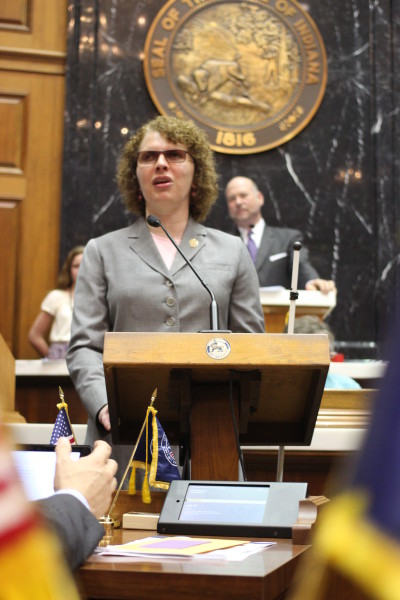 “I’m grateful for my challenges because they have pushed me in ways that are invaluable, making me more compassionate for others and very aware we all are carrying our own baggage.”
“I’m grateful for my challenges because they have pushed me in ways that are invaluable, making me more compassionate for others and very aware we all are carrying our own baggage.”
Kathy Nimmer couldn’t have said it better — especially since she’s a 10th grade English teacher who also teaches creative writing and senior college composition.
It’s almost the end of the school year, but it’s the beginning of a new adventure for Nimmer. As 2015 Indiana Teacher of the Year, she’ll be spending the majority of the 2015-2016 school year traveling around the state, visiting various schools and community groups and giving speeches and workshops.
So what specific challenge is Nimmer grateful for? Being blind.
Learning about losing vision
Born in the Chicagoland area, Nimmer attended elementary school in Munster, Ind., a great place to grow up.
“There was the community feel of a small town, but we also had access to the city feel of Chicago,” she said. Although she wouldn’t call herself a loner, she definitely was content to go off and play by herself.
“I didn’t need the companionship of others,” Nimmer said. “I had quite the imagination, and I loved to go bicycling around the neighborhood and let all the stories in my head run wild.” And it wasn’t just thoughts in her head that ran — Nimmer did a lot of that too.
“I loved gymnastics, and I was a great runner, so it was always fun for me in gym and field days to show that off and use those physical strengths I had,” she said. That made it all the more difficult for her when she began to lose her vision. One particular memory in the early stages of her vision loss was the rope climb she did in gym class.
“The coach encouraged me to do the rope climb, and I can still picture climbing to the top of the gym ceiling and ringing that bell,” she said. “I think he knew I needed to celebrate an accomplishment and have something like that to be proud of. It made me believe everything was going to be okay.” Nimmer started to struggle with her vision around second grade.
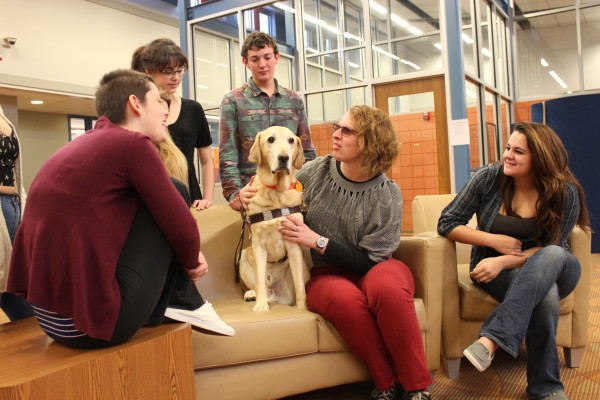 “I couldn’t distinguish the slight differences between certain letters when they were written on the chalkboard,” she said. “Many kids get glasses around that time, so it didn’t seem like a big deal.” With her teacher’s recommendation, Nimmer had her eyes checked, and no trauma was detected.
“I couldn’t distinguish the slight differences between certain letters when they were written on the chalkboard,” she said. “Many kids get glasses around that time, so it didn’t seem like a big deal.” With her teacher’s recommendation, Nimmer had her eyes checked, and no trauma was detected.
“The doctors thought I was making it up because they didn’t find a particular problem, so it took a while to be diagnosed correctly.” Thankfully, her parents believed her and were persistent in getting Nimmer care.
Misdiagnosed at first, Nimmer was a third grader when she became a research patient at the University of Chicago. She was diagnosed with cone-rod dystrophy, which results from a primary loss of cone photoreceptors, followed by a loss of rods.
The genetic disorder characteristically leads to early impairment of vision. An initial loss of color vision and of visual acuity, due to loss of cone function, is followed by night blindness and loss of peripheral visual fields, due to loss of rod function.
“Basically the cones and rods began to die in the middle of my retina, which is most important in the visual process,” Nimmer said. “As they died, they left scars, causing me to lose sight.”
Now, she only has very little light perception, but she had to adjust to the blindness in stages as her vision continued to get worse.
A lesson in adjustment
Nimmer stayed in public school through fifth grade, using magnifying equipment to help her to see. Then in sixth grade, she began to attend the Indiana School for the Blind as a boarding student.
“That was very hard,” she said. “I was eleven when I left home, and I was already very shy. I just wasn’t sure I could make the transition. I left for the bus station from home every Sunday after church, and then I came home on Friday evening.” Her diagnosis is a fairly uncommon one with an unpredictable trajectory.
“No one knew how bad it could really get,” she said. “My vision was stable for a number of years, but then every four years or so, it would decline to another level. And just as I came to adjust to a different way of functioning in that stage, my sight would slip again.”
Manifesting itself in different ways with each individual, the disease may only cause poor color vision or sensitivity to bright lights. In other cases such as Nimmer’s, it may cause complete loss of sight.
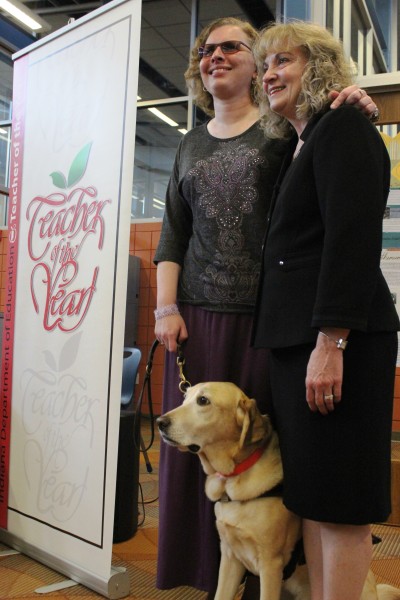 “I was still able to read large print materials until I got to my freshman year of high school,” she said. “Then I had to learn Braille.” That in itself was a very emotional time for Nimmer.
“I was still able to read large print materials until I got to my freshman year of high school,” she said. “Then I had to learn Braille.” That in itself was a very emotional time for Nimmer.
“I was a teenager, so I was emotional anyway,” she said. “In my mind as long as I could read print, I was still a sighted person. But once I had to learn to read Braille, I was blind. It made me very uncomfortable for quite a while. It was hard to deal with and made me feel like I wasn’t who I used to be — that I was a lesser person.”
She turned back to her long-time saving grace — her imagination. Even in the hardest times, Nimmer could lose herself in reading and writing or making up stories on the long bus rides back and forth from Munster to Indianapolis.
“My faith also became a much more personal part of my life,” Nimmer said. “Church wasn’t just a routine. There was a very special pastor who helped me through some of my roughest moments during high school, when everything in my future and life seemed so uncertain. Faith became that unmovable anchor for me.”
And her parents continued to be her strongest supporters and advocates. Of course, they wept right along with Nimmer, but they made sure she knew she could do anything she wanted to do and never held her back from trying new things.
Chance to see in a different way
Seven years Nimmer stayed at the Indiana School for the Blind, middle school through high school. In addition to Braille, she took a mobility class focused on cane travel, which gave the students an opportunity to earn travel freedoms around the campus and nearby community.
She also took home economics, now known as family and consumer sciences. But students were taught how to label and cook food tailored for people with vision problems. And a perk for Nimmer was the athletics program adapted for blind students.
“There were such great opportunities for me at the School for the Blind,” she said. “I was very athletic and got to continue to enjoy that side of myself, plus the chance to explore and grow my leadership through student council. I would have been swallowed up in a mainstream school.”
Nimmer found something else — another way to tap into her creative abilities: the piano.
“We had to take piano or band or choir, and when I was forced to choose, it opened up the door to a new love for me,” she said. “Playing the piano helped me grow and became another outlet for me, giving me the chance to gain confidence in myself as both a performer and a person.”
She started to play when she still had partial vision left, but then she learned how to read Braille music. As laborious as that process is, the thoroughness helped her to better memorize the pieces she learned to play.
“It didn’t matter that I couldn’t see,” she said. “To be able to have a lovely gift of music to share with others, it reminded me that we may set goals of what we want to do with our lives, but we have to be open-minded. You never know what will come your way and what abilities you may have that you won’t discover if you aren’t willing to try different things. It’s a glorious gift to have a prize like that.”
In a graduating class of 12 students, Nimmer got to experience a lot of one-on-one time with her teachers, learning from their commitment and establishing personal connections with them.
“It ignited the teaching flame for me,” she said.
An educational journey
Due to its smaller campus and Christian foundation, Trinity Christian College in Palos Heights, Ill., was the college of choice for Nimmer. She entered as an education major.
“I applied to a few places, but the key for me was to be a little closer to home,” she said. “I didn’t feel I was ready to go from a tiny campus like the School for the Blind to something too big. And I also wanted a Christian college to keep me well-rounded and continue my focus on faith.”
Trinity didn’t have a previously-established program for disabled or blind students, but they were willing to accommodate and customize access for Nimmer. She arrived at campus early to get to know where buildings were, a general sense of distance and become more familiar with directions.
“You also have to be willing to ask for help,” she said. “I was, of course, disoriented here and there, but I had a great group of friends.” She became even more observant and highly aware of her surroundings, including a heightened sense of hearing cues. That would serve her well in her future days as a teacher.
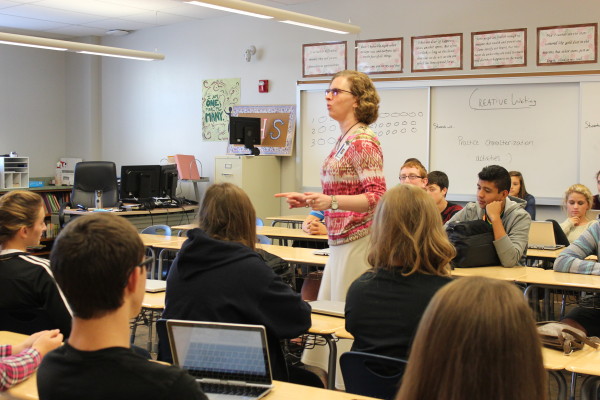 She received her Bachelor of Arts in English education, with a minor in communication and special education. Her early days of student teaching were rough, and she decided she wanted another weapon in her back pocket for when it came time to find a job. So she got her master’s degree in English from Purdue University.
She received her Bachelor of Arts in English education, with a minor in communication and special education. Her early days of student teaching were rough, and she decided she wanted another weapon in her back pocket for when it came time to find a job. So she got her master’s degree in English from Purdue University.
“My brother had attended Purdue Calumet near where we grew up, and I always saw Purdue from a distance during my trips to and from Indianapolis,” Nimmer said. “I didn’t want to travel too far from home, and Purdue seemed like the right fit.” Who would have guessed West Lafayette would become her permanent home.
Nimmer was hired by Jim Garver, the principal of Harrison High School in West Lafayette.
“He wanted to take risks, be the first person to do things,” Nimmer said. This would certainly fall under that category — hiring the school’s first blind teacher. “For years, the professors at Trinity helped me think through my decision to teach and how to prepare. But the more direct negativity came when I started to do interviews for teaching jobs. I don’t blame them for worrying and having preconceived notions about a blind teacher, but they thought there was no way to overcome it or compensate for it.”
That made Garver’s attitude all the more refreshing.
“He found it to be groundbreaking, and I really appreciated that opportunity,” she said. “I didn’t care why I was hired, just that I was hired and was being given the chance to try … and fail or succeed.” A door was opened, and Nimmer never looked back.
Getting the classroom experience
“I started my first day in 1992, and it was intimidating,” she said. Nimmer was nervous to move much beyond a podium in the classroom, but she knew she needed to be out there among the students.
“When I finally found that courage, I started to bump into things because that was part of it. But it also forced me to be more upfront about my disability and learn to use humor,” she said. “It’s a necessity to be very open and forthcoming — and laugh about it too.”
How is Nimmer’s classroom different? There is a different seating arrangement, with desks divided down the middle of the room and three rows of students on each side. It helps her learn her students by voice and also to monitor what’s going on in the room more easily.
And students don’t raise their hands — they call out their names. At first, it’s awkward for some, but Nimmer is upfront at the beginning of the year that this is the way the classroom runs.
“It’s important keeping the rows straight so I can safely move around,” she said. “The students at first don’t pay much attention to the environment, but as soon as I bump into something, they act to move it. They learn to care about each other and me because I care about them. It’s about building that respect and the sense we are all in this together.”
In her early days, Nimmer had to have student aides or readers read each student’s paper to her one by one. Then came scanners and computers — each time technology improved, her teaching life got a bit easier.
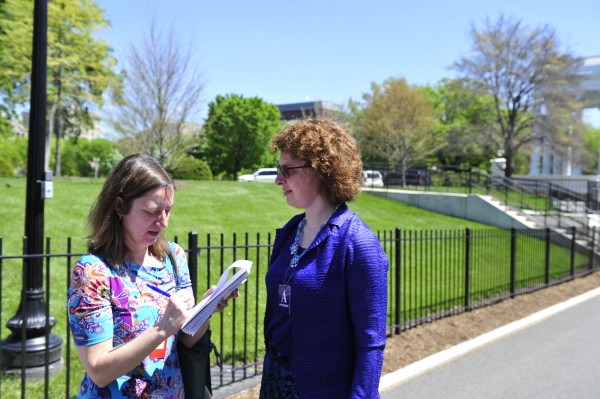 “Assistive technology has made my life so much easier,” she said. “Tasks that would take hours and hours and require the assistance of sighted people I can now do on my own.”
“Assistive technology has made my life so much easier,” she said. “Tasks that would take hours and hours and require the assistance of sighted people I can now do on my own.”
She uses Window-Eyes, a customizable screen reader that enables people who are blind or visually impaired to be completely independent on a PC. For writing, Nimmer uses Kidblog, a platform offering a way for students to publish writing safely and privately online. And she also has an Everest Braille Embosser to make handouts she can read independently.
Along with the advances in technology, Nimmer developed a stronger teaching persona, learning once she started to be more animated and creative with the class, the students were more engaged. And better behaved.
Then, in her 21st year of teaching, Nimmer got the biggest shock of her life. She was chosen as Harrison’s Teacher of the Year.
Teacher of the Year and beyond
“I never thought I would win because I couldn’t shake off those hard times at the beginning of my teaching career,” Nimmer said. “I knew that while I was doing well now, my history at the school had started off so poorly. It was the most shocking day.” And the journey didn’t end there.
Then came the most personally gratifying honor — Tippecanoe School Corporation Teacher of the Year.
“I had always taught in this school corporation, and for them to recognize me and realize my heart was here and that I was making a difference was truly a wonderful honor,” she said.
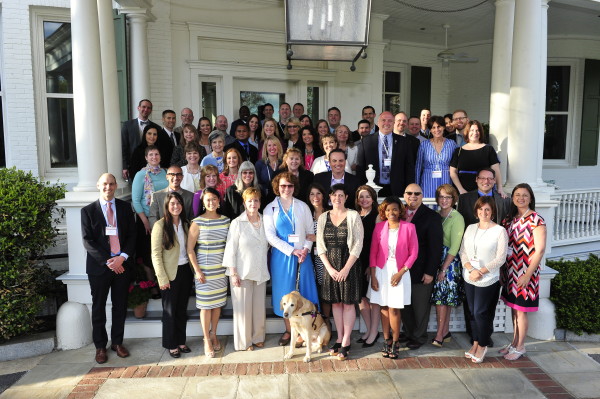 With that award, Nimmer was automatically nominated for Indiana Teacher of the Year. That nomination process included a 21-page portfolio, essay questions and references.
With that award, Nimmer was automatically nominated for Indiana Teacher of the Year. That nomination process included a 21-page portfolio, essay questions and references.
“My goal was to get in the top 10, but that was more of a quiet goal,” Nimmer said. It was a quiet goal that was achieved — along with being in the top three finalists.
After a group of judges visited Nimmer’s classroom to see her in her element, the news finally came on Sept. 30, 2014 — she won. She was the 2015 Indiana Teacher of the Year. And although she ultimately wasn’t selected, she was also one of just four finalists for the National Teacher of the Year.
“I didn’t know what to think about all of it,” she said. “I didn’t expect it to keep going at any of the stages, and I was just blown away each and every time. It’s quite odd because this is certainly not a career you do for the awards. It all feels surreal, and I will forever have this as a part of my journey.”
It’s a journey that took her to Washington, D.C. A part of the National Teacher of the Year Program, Nimmer and her guide dog Elias made the trip and got the chance to tour the Oval Office and Rose Garden along with meeting and talking with President Obama.
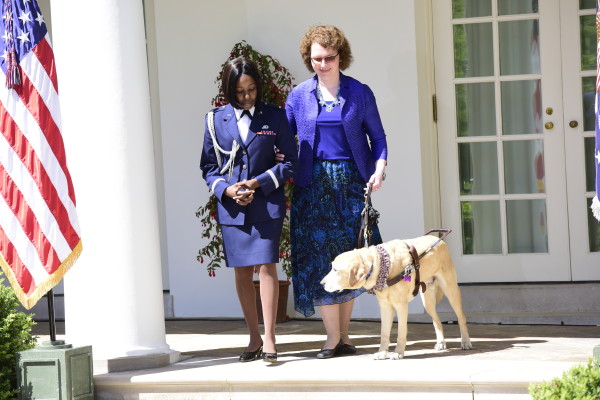 “Elias has been with me seven and a half years, and it’s time for him to retire,” she said. “But the trip to Washington felt like a full circle moment for me. Elias and I walked out on our own from the Oval Office to the middle of the stage in the Rose Garden while the crowd clapped for us. He started with me years ago on this journey, and we took the stage as he comes to the closing stage of his guide dog career. He even drank from Bo’s water bowl!”
“Elias has been with me seven and a half years, and it’s time for him to retire,” she said. “But the trip to Washington felt like a full circle moment for me. Elias and I walked out on our own from the Oval Office to the middle of the stage in the Rose Garden while the crowd clapped for us. He started with me years ago on this journey, and we took the stage as he comes to the closing stage of his guide dog career. He even drank from Bo’s water bowl!”
Her third guide dog and first from Guiding Eyes for the Blind, Elias has been by her side each step of the way. Now he’s off to enjoy his retired years with Nimmer’s parents as she gets a new companion for the next stage of her life. It’s a stage that will start with traveling the Hoosier state as the Teacher of the Year — and Nimmer couldn’t be happier.
“There are so many great untold stories within our schools, and I want to learn from those stories while giving back to the teaching community with the lessons I’ve learned,” she said. “If I can inspire just one person to face a challenge that will help him or her grow into a stronger person along the way — that makes this next year even more of an adventure, and I’m excited to see what the future holds.”
